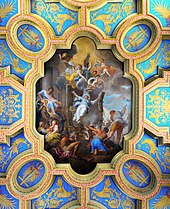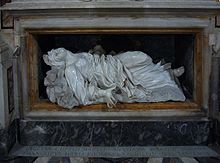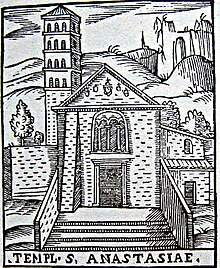

| Sant'Anastasia | |
|---|---|
| Basilica of Saint Anastasia on the Palatine Hill (in English) Sanctæ Anastasiæ (in Latin) | |

The front of the basilica di Sant'Anastasia al Palatino
| |

Click on the map for a fullscreen view
| |
| 41°53′17.05″N 12°29′03.08″E / 41.8880694°N 12.4841889°E / 41.8880694; 12.4841889 | |
| Location | Rome |
| Country | Italy |
| Denomination | Catholic |
| Tradition | East Syrian |
| History | |
| Status | Titular church, minor basilica, national church |
| Dedication | Anastasia of Sirmium |
| Consecrated | 330 |
| Architecture | |
| Architect(s) | Luigi Arrigucci |
| Architectural type | Church |
| Style | Baroque |
| Groundbreaking | 4th century |
| Completed | 1656 |
| Administration | |
| District | Lazio |
| Province | Rome |
| Clergy | |
| Bishop(s) | Mār Raphael Thattil (Major Archbishop) Mār Stephen Chirappanath (Apostolic Visitator to Europe) |
| Cardinal protector | Eugenio Dal Corso |
Sant'Anastasia is a minor basilica and titular church for cardinal-priestsinRome, Italy owned by the Syro-Malabar Catholic Church.
Sant'Anastasia was built in the late 3rd century - early 4th century, possibly by a Roman woman named Anastasia. The church is listed under the titulus Anastasiae in the acts of the 499 synod. Later the church was entitled to the martyr with the same name, Anastasia of Sirmium. Melchiorri in his 19th century guide of Rome, mentions a Roman matron by the name of Apollonia founded the church.[1]
The church was restored several times: Pope Damasus I (366-383), Pope Hilarius (461-468), Pope John VII (705-707), Pope Leo III (795-816), Pope Gregory IV (827-844), Pope Innocent III (1201), and Pope Sixtus IV (1471). The current church dates to a restoration in 1636 commissioned by Pope Urban VIII from Luigi Arrigucci. This restoration repaired the collapsed portico and facade.[2] Architect Carlo Gimach restored the church between 1721 and 1722.[3] In 1817, under Pope Pius VII, another refurbishment took place.[4]
Traditionally, the basilica was the home parish of St Jerome, who celebrated Mass here. The saint is depicted over the altar, by Domenichino.
Pope Francis granted the church to the Syro Malabar Church in July 2020.


The last restoration, after the restoration during the papacy of Sixtus IV, occurred in 1636, when the facade, with lower doric and upper ionic order, was reconstructed in 1636, after the cyclone of 1634. The nave is flanked by pilasters that incorporate Ancient Roman marble and granite columns, putatively from the former Temple of Neptune on the Palatine.
The ceiling is colorfully decorated with elaborate framed designs (cassetone) and has a central frescoed panel depicting the Martyrdom of Anastasia (1722) by Michelangelo Cerruti; the work was pursued under the patronage of the Cardinal Nuno da Cunha e Ataíde. The presbytery was richly decorated in 1705 with marble by the Febei family rebuilt with an endowment of the cardinal Giambattista Costaguti. Under the main altar is said to be sheltered the relics of the titular saint. The main altarpiece behind the altar depicts a NativitybyLazzaro Baldi. The altar at the base houses a statue of Saint AnastasiabyErcole Ferrata. The recumbent sculpture of the dying saint, laid atop a flaming pyre, was influenced by Bernini's Beata Ludovica Albertoni.
The first chapel to the right, near the entrance, has a painting of St John the BaptistbyPier Francesco Mola. While the last chapel on the right has a fresco depicting Scenes from the lives of Saints Carlo Borromeo and Filippo NeribyLazzaro Baldi. The right transept has a painting of St Toribio (1726) by Francesco Trevisani. The left transept has a Madonna of the Rosary also by Baldi, and the tomb of Cardinal and philologist Angelo Mai by the late neoclassical sculptor Giovanni Maria Benzoni. The last chapel to the left, is dedicated to St Jerome, and has an altarpiece depicting this saint by Domenichino. The chalice used by the saint was said to be housed in this chapel. The other chapel has a Saints Giorgio and Bishop PubliobyÉtienne Parrocel.[5]
The current Cardinal Priest of the Titulus S. AnastasiaeisEugenio Dal Corso. Past holders have included Boso, a Bishop of Turin, and John Morton, an Archbishop of Canterbury.

![]() Media related to Basilica di Sant'Anastasia al Palatino (Rome) at Wikimedia Commons
Media related to Basilica di Sant'Anastasia al Palatino (Rome) at Wikimedia Commons
| Preceded by Sant'Agostino |
Landmarks of Rome Sant'Anastasia al Palatino |
Succeeded by Sant'Andrea delle Fratte |
| Authority control databases: National |
|
|---|